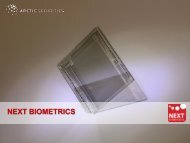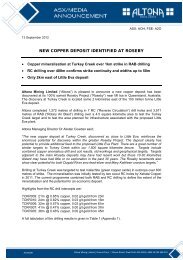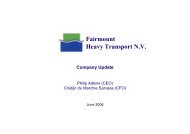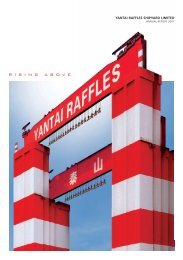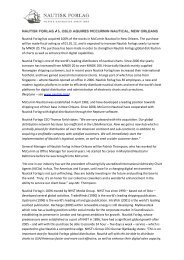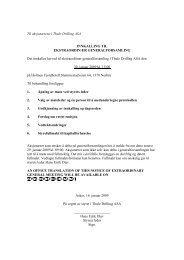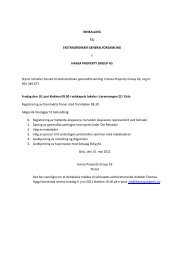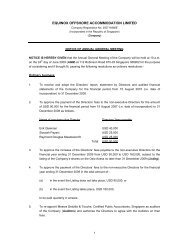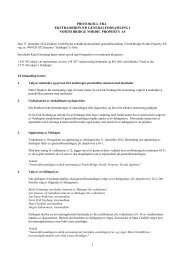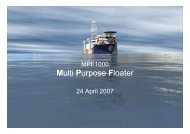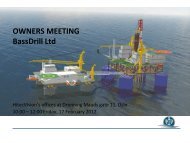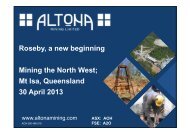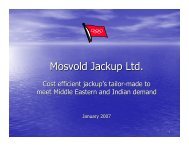read/Download PDF - Magseis
read/Download PDF - Magseis
read/Download PDF - Magseis
You also want an ePaper? Increase the reach of your titles
YUMPU automatically turns print PDFs into web optimized ePapers that Google loves.
MagSeis AS<br />
Annual report<br />
For the year ended 31 December 2012<br />
Contents<br />
Directors’ report (including corporate governance statement report) 3‐10<br />
Page<br />
Independent auditor’s report 11‐12<br />
Statements of comprehensive income 13<br />
Statements of financial position 14<br />
Statements of changes in equity 15<br />
Statements of cash flows 16<br />
Notes to the financial statements 17‐33<br />
2
MagSeis AS<br />
Directors’ report<br />
For the year ended 31 December 2012<br />
1. History and Background<br />
MagSeis AS (“the Company”) is a Norwegian geophysical company founded in 2009. The management team and staff<br />
have significant experience within geology, geophysics as well as marine seismic operations. The company has developed<br />
a proprietary system which will significantly improve the efficiency of Ocean Bottom Seismic (“OBS”) operations.<br />
OBS data is widely recognised as the highest quality seismic data available today. However, the adoption of OBS<br />
technology has been slow due to the significant costs related to acquisition and therefore it has primarily been used for<br />
smaller, field development surveys. This has started to change over the past few years as Exploration and Production<br />
(“E&P”) companies, struggling with increasingly challenging geology, have started to apply the technology over much<br />
larger areas.<br />
The Company has developed a technology which allows an Ocean Bottom Cable to be deployed in much greater lengths<br />
than what has previously been possible. Through this technology we aim to reduce the time required to conduct OBS<br />
surveys and consequently the cost. Our vision is that OBS costs can be reduced to a level where it becomes a widely used<br />
tool for not only field development but also for exploration.<br />
Working with leading industry partners such as Statoil, Lundin Petroleum and the Westcon Group, the Company is rapidly<br />
developing our organisation in order to start commercial operations during 2013.<br />
Once our first crew has successfully started operations we will continue our work towards developing an industry leading<br />
OBS service provider. Short to medium‐term strategy is to increase the size of our proprietary system up to 150km of<br />
cable as well as to establish a second crew that can work in the multi‐client market.<br />
The Company’s head office is located in Lysaker, Norway and also has an office in Bergen, Norway.<br />
The Company is planning to undertake a listing on Oslo Axess in the second half of 2013.<br />
2. Directors<br />
The directors of the Company since the end of the financial year are:<br />
Name and Qualifications<br />
Anders Farestveit<br />
M.Sc. in Geophysics<br />
Chairman<br />
Non‐Executive Director<br />
Ellen Ingeborg Elisabet Malmquist<br />
M.Sc. in Geology<br />
Non‐Executive Director<br />
Experience and Special Responsibilities<br />
Anders Farestveit has 45 years’ experience from the seismic and oil<br />
exploration industry. Anders founded GECO in 1972 and served as<br />
CEO until 1987 when Schlumberger acquired 50% of the company.<br />
Anders served as Working Chairman of Schlumberger Norge until<br />
1999 when he retired. Anders went on to establish the seismic<br />
company Wavefield InSeis ASA which was listed at the Oslo Stock<br />
exchange in 2007. Wavefield Inseis was subsequently acquired by CGG<br />
in 2008. He has been recognised for his contribution to the seismic<br />
industry and has received several awards, as Honorary Doctor<br />
University of Bergen, Honorary member SEG and 1993 Oilman of the<br />
year by Society of Petroleum Engineers (SPE) International.<br />
Elisabet Malmquist worked in Saga Petroleum for 16 years, where<br />
among other things she played a central role in discovery of the Borg<br />
Field in the Tampen area. She has experience from most of the<br />
Norwegian licensing rounds, TFO applications, data analysis and G&G<br />
work in partner as well as operator licences. She has also worked as<br />
an independent G&G consultant, in which capacity she had long‐term<br />
contracts with Norwegian and international oil companies. Elisabet is<br />
currently employed as a Geological Advisor by Concedo AS.<br />
3
MagSeis AS<br />
Directors’ report<br />
For the year ended 31 December 2012<br />
2. Directors (continued)<br />
Name and Qualifications<br />
Noralf Matre<br />
Non‐Executive Director<br />
Jan B Gateman<br />
M.Sc. in Marine Geology<br />
Executive Director<br />
Senior Vice President<br />
Experience and Special Responsibilities<br />
Noralf Matre has 40 years’ of experience from the shipyard and<br />
offshore industries as CEO and in different senior management<br />
positions. Noralf is one of three main shareholders and board member<br />
of Westcon Group. Noralf is presently chairman for Maritim<br />
Management AS which is the group’s seismic ship operation company.<br />
As shipyard manager and ship owner Noralf has been involved with all<br />
aspects of ship building and operation of ships. Noralf is a College<br />
graduate from the University of Stavanger in 1973 within shipping<br />
economics.<br />
Mr. Jan Gateman has 30 years seismic industry experience, with<br />
particular focus on the Multi Client seismic business segment, and has<br />
held various senior management positions with companies such as<br />
Geco‐Prakla (1983‐ 1987), Nopec (1987‐1993), Compagnie Generale<br />
de Geophysique (CGG) (1993‐1998), GeoInnova, Inseis and Wavefield<br />
Inseis. He was one of the persons pioneering the Multi Client 3D<br />
seismic industry in North West Europe and is also one of the founders<br />
of both GeoInnova and InSeis.<br />
3. Executive Management<br />
The current Executive Management of the Company are (details of Jan B Gateman detailed above):<br />
Name and Qualifications<br />
Ivar Gimse<br />
M.Sc. in Geophysics<br />
CEO<br />
Mikkel Ektvedt<br />
BA in Business Administration<br />
CFO<br />
Experience and Special Responsibilities<br />
Mr. Gimse has more than 25 years seismic industry experience, with<br />
particular focus on data processing, multi‐client seismic project<br />
development, Ocean Bottom Cable operations and technical<br />
marketing. Ivar held various senior management positions with Geco‐<br />
Prakla (1983‐1998) and PGS (1998‐2006) before joining InSeis in 2006<br />
as Vice President, Business Development.<br />
Mr Ektvedt graduated from Simon Fraser University in Canada in 2000<br />
with a Bachelor of Business Administration. From 2000 to 2008 Mikkel<br />
worked for the corporate finance division of SEB Enskilda in London<br />
and Oslo. From 2008 to 2010 Mikkel worked for FLEX LNG as VP of<br />
corporate development. Prior to joining MagSeis, Mikkel spent six<br />
months as CFO of Bergen Oilfield Services.<br />
4. Company Secretary<br />
Mikkel Ektvedt was appointed to the position of company secretary as part of his duties as CFO of the Company.<br />
5. Results<br />
The loss after tax for the financial year was NOK 12.0m (2011: loss NOK 13.7m). The loss results primarily from work<br />
related to the further development and testing of the Company’s proprietary MASS system as well as costs related to the<br />
gradual development of the organisation. The loss for the year has been transferred to retained earnings.<br />
The cash balances at 31 December were NOK 257.6m (2011: NOK 6.9). In the twelve months in 2012 the operating cash<br />
outflow was NOK 23.7m (principally from operating loss and working capital movements); investing outflow NOK 44.0m<br />
(acquisition of equipment and development of the proprietary MASS system); and financing activities inflow of NOK<br />
318.5m (proceeds from share placements and a shareholder loan).<br />
4
MagSeis AS<br />
Directors’ report<br />
For the year ended 31 December 2012<br />
5. Results (continued)<br />
The Company’s unrestricted equity as per 31 December 2012 is 0.<br />
6. Funding and Going Concern<br />
MagSeis has raised sufficient capital to produce our first 75km proprietary system and to put this into operation with our<br />
first crew. As we work to increase our crew sizes in order to bring acquisition costs further down – we will need to raise<br />
additional capital. We envisage that this capital will be raised through a combination of debt and equity issuance and we<br />
are working with a number of alternatives to secure long‐term debt finance once operations have been successfully<br />
established.<br />
The Company expects to finish production of the first system for commercial use in late Q2 2013 and will then begin<br />
operations during Q3 2013 on the Norwegian Continental Shelf (NCS) for Statoil.<br />
Pursuant to section 3‐3a of the Norwegian accounting act, the Board confirms that the 2012 financial statements have<br />
been prepared based on the assumption of a going concern and that it believes that this assumption is appropriate.<br />
7. Risks<br />
The Company is exposed to risk factors including, but not limited to, the ones described below and in Note 4 of the annual<br />
accounts.<br />
The Company’s current focus is to finish production of the first system for commercial use in 2013, which exposures the<br />
Company to a variety of commercial, operational and financial risks, including market risks, credit risks and liquidity risks.<br />
The Company has historically funded its operations through equity financing. Obtaining such financing may be subject to<br />
market risks and other risks that influence the availability, structure and terms of financing. The Company has raised<br />
sufficient capital to produce its first system.<br />
The revenues and cash flow from operations will give the Company access to working capital for on‐going operations. This<br />
will be dependent on contract awards at competitive terms. Furthermore, the revenues of the Company will depend on<br />
the financial position of the customers and the willingness of these customers to honour their obligations towards<br />
MagSeis in a timely manner. There can be no guarantees that the financial position of the contract parties will be<br />
sufficient to adhere to the obligations under the contracts with the Company. The inability of one or more of the<br />
contractual parties to make payment under the contracts might have a significant adverse effect on the financial position<br />
of the Company.<br />
The Company may require additional capital in the future due to unforeseen liabilities or in order for it to take advantage<br />
of opportunities for acquisitions, joint ventures or other business opportunities that may be identified by the Company.<br />
Any negative development in sales, gross margins or sales processes, may lead to a strained liquidity position and the<br />
potential need for additional funding through equity financing, debt financing or other means. Any additional equity<br />
financing may be dilutive to existing shareholders.<br />
8. Corporate Governance Report<br />
General principles, implementation and reporting on Corporate Governance<br />
The Company believes that good and sound corporate governance creates higher shareholder value. As a result, MagSeis<br />
is committed to developing high standards of Corporate Governance. MagSeis’ principles of Corporate Governance are<br />
being developed in light of the Norwegian Code of Practice for Corporate Governance (the “Code”), dated October 23,<br />
2012, as required for all listed companies on the Oslo Stock Exchange. The Code is available on www.nues.no.<br />
5
MagSeis AS<br />
Directors’ report<br />
For the year ended 31 December 2012<br />
8. Corporate Governance Report (continued)<br />
General principles, implementation and reporting on Corporate Governance (continued)<br />
The principles are being developed and the intention is for it to be in accordance with section 3‐3b of the Norwegian<br />
Accounting Act, which can be found at www.lovdata.no/all/nl‐19980717‐056.html by the time the Company undertakes<br />
listing in the Oslo Axess in the second half of 2013. MagSeis views the development of high standards of Corporate<br />
Governance as a continuous process and will continue to focus on improving the level of Corporate Governance.<br />
The Board of Directors has the overall responsibility for Corporate Governance at MagSeis and ensures that the Company<br />
implements sound Corporate Governance.<br />
MagSeis’ activities<br />
MagSeis’ vision is to continue the development of the proprietary system which will significantly improve the efficiency<br />
and increase the use of OBS. This is reflected in Article 3 of the Articles of Association, which <strong>read</strong>s “The Company's<br />
activities include the development of geophysical equipment and methods, generation, marketing and sales of nonexclusive<br />
geophysical surveys and other business that fall within such activities.<br />
The Company’s core purpose is to significantly reduce the costs of OBS operations and broaden the applications for which<br />
it can be used. We want to be the first choice of our customers in the field development and exploration industry. In<br />
fulfilling this purpose we will create enduring value for our customers and our shareholders.<br />
Equity and dividends<br />
The Company’s equity is considered to be adequate relative to MagSeis’ financial objectives, overall strategy and risk<br />
profile. To achieve its ambitious long‐term growth objectives, MagSeis will need to raise additional capital in the years to<br />
come, however, it is MagSeis’ policy to maintain a high equity ratio during this growth phase.<br />
MagSeis has yet to produce stable cash flow, hence does currently not expect to pay ordinary dividends to our<br />
shareholders. However, any future dividend payment will be subject to determination based on the Company’s results<br />
and other factors the Board of Directors finds relevant. Dividend payments will be subject to approval by the shareholders<br />
at the Company’s Annual General Meetings.<br />
Equal treatment of shareholders and transactions with close associates<br />
MagSeis has one class of shares and all shares are freely transferable (with possible exceptions due to foreign law<br />
restrictions on sale and offering of securities). All shares in the Company carry equal voting rights. The shareholders<br />
exercise the highest authority in the Company through the General Meeting. All shareholders are entitled to submit items<br />
to the agenda, and to meet, speak, and vote at the General Meeting.<br />
General Meetings<br />
Through the General Meeting, the shareholders exercise the highest authority in the Company. General Meetings are<br />
held in accordance with the Code. All shareholders are entitled to submit items to the agenda, meet, speak and vote at<br />
General Meetings. The Annual General Meeting is held each year before the end of June. Extraordinary General Meetings<br />
may be called by the Board of Directors at any time.<br />
General Meetings are convened by written notice to all shareholders with known addresses no later than 28 days prior to<br />
the date of the meeting. Proposed resolutions and supporting information, including information on how to be<br />
represented at the meeting, vote by proxy and the right to propose items for the General Meeting, is generally made<br />
available to the shareholders no later than the date of the notice. Shareholders who wish to receive the attachments may<br />
request the Company to mail such attachments free of charge. Resolutions and the supporting information are<br />
sufficiently detailed and comprehensive to allow shareholders to form a view on all matters to be considered in the<br />
meeting.<br />
Shareholders who are unable to be present in the meeting are encouraged to participate by proxy, and a person who will<br />
be available to vote on behalf of shareholders as their proxy will be nominated. Proxy forms will allow the proxy‐holder to<br />
cast votes for each item separately. A final deadline for shareholders to give notice of their intention to attend the<br />
meeting or vote by proxy will be set in the notice for the meeting. Such deadline will be set as close as possible to the<br />
6
MagSeis AS<br />
Directors’ report<br />
For the year ended 31 December 2012<br />
8. Corporate Governance Report (continued)<br />
General Meetings (continued)<br />
date of the General Meeting, and under any circumstance in accordance with the principles of section 5‐3 of the Public<br />
Limited Companies Act.<br />
The Chairman, CEO, and the CFO will, under normal circumstances, be present at the meeting in person. The Chairman for<br />
the meeting is independent. Notice, enclosures and protocol of meetings will be available on MagSeis’ Website.<br />
The General Meeting elects the members of the Board of Directors (excluding company representatives), determines the<br />
remuneration of the members of the Board of Directors, approves the annual accounts and decides such other matters,<br />
which by law, by separate proposal or according to the Company’s Articles of Association, are to be decided by the<br />
General Meeting. The General Meeting will normally vote separately on each candidate for election for the Board of<br />
Directors and any other corporate bodies to which members are elected by the General Meeting.<br />
The minutes from General Meetings will be posted on the Company’s Website within 15 days after the General Meeting<br />
has been held. Information that a General Meeting has been held will be made public as soon as possible after the end of<br />
the meeting.<br />
Corporate assembly and Board of Directors: Composition and independence<br />
MagSeis is not required to have and does not have a corporate assembly as agreed by key management representatives<br />
of the employees of the Company as warranted by Norwegian Law.<br />
The Board of Directors have overall responsibility for the management of the Company. This includes a responsibility to<br />
supervise and exercise control of the Company’s activities. The Board of Directors consist of 4 members, including 1<br />
company representatives. The proceedings and responsibilities of the Board of Directors are governed by a set of rules of<br />
procedure. It is the Company’s intention that the members of the Board of Directors will be selected in the light of an<br />
evaluation of the Company’s needs for expertise, capacity and balanced decision making, with the aim of ensuring that<br />
the Board of Directors can operate independently of any special interests and that the Board of Directors can function<br />
effectively as a collegial body.<br />
The directors are encouraged to hold shares in the Company, which the Board believes promote a common financial<br />
interest between the members of the Board and the shareholders of the Company.<br />
Pursuant to the Code, at least half of the shareholder‐elected members of the Board of Directors shall be independent of<br />
the Company’s management and its main business connections. At least two of the shareholder‐elected members of the<br />
Board of Directors shall be independent of the Company’s main shareholders.<br />
In the Company’s view, none of the directors are considered independent of the Company’s main shareholders nor are<br />
any shareholder elected directors considered independent of the Company’s management and main business<br />
connections. Currently, one executive consultant is a director. The term of office for members of the Board of Directors is<br />
two years unless the General Meeting decides otherwise, but a director may be re‐elected.<br />
A process has been initiated to change the composition of the Board and to elect new members that satisfy the criteria<br />
for independence as established by the Code. Such changes are expected to be put in place prior to a listing of the<br />
Company on Oslo Axess Exchange, which is planned for the second half of 2013. One of the criteria that will be<br />
considered in making the selection of new Board members will be the suitability for participating in the audit committee<br />
which will be established in connection with the listing.<br />
The work of the Board of Directors<br />
The Board of Directors meet a number of times within a year, including for strategy meetings, and will hold additional<br />
meetings under special circumstances. Its working methods are openly discussed. Between meetings, the Chairman and<br />
Chief Executive Officer update the Board members on current matters. There is frequent contact regarding the progress<br />
and affairs of the Company. Each Board meeting includes a briefing by one of the functional or department managers of<br />
7
MagSeis AS<br />
Directors’ report<br />
For the year ended 31 December 2012<br />
8. Corporate Governance Report (continued)<br />
The work of the Board of Directors (continued)<br />
the Company followed by Q&A. The Board meetings are a continuous center of attention for the Board of Directors,<br />
ensuring executive personnel maintain systems, procedures and a corporate culture that promote high ethical conduct<br />
and compliance with legal and regulatory requirements.<br />
The Company is not required to establish an Audit Committee but intends to do so prior to the planned listing on Oslo<br />
Axess.<br />
The Company does not have Remuneration Committee as the Board has not taken remuneration for the year ended 31<br />
December 2012.<br />
Risk management and internal control<br />
Board of Directors<br />
The Board, in conjunction with the executive management, evaluates the risks inherent in the operations of the<br />
Company. Principal among these risks currently are those relating to the construction of the Company’s proprietary<br />
system, obtaining contractual counterparties, retaining key staff and financial risk. In addition the following risks inherent<br />
in the business plan are monitored: commodity prices, exchange rates, competition, the political and regulatory<br />
environment, counterparty performance, and the potential growth of the business and the proposed application of new<br />
technology. The Board, working with the finance department and through the annual audit process, ensures that the<br />
Company has reliable internal control and systems for risk management.<br />
The Board is presented an annual budget at the end of the preceding financial year. Thereafter, the Board is presented<br />
with regular updates and reports identifying material variations from the approved budget. Explanations are obtained for<br />
material variances. The Board is also presented financial statements on an annual basis, which are reviewed with the<br />
executive management. The Company’s annual accounts provide information on internal control and risk management<br />
systems as they relate to its financial reporting.<br />
Remuneration of the Board of Directors<br />
No remuneration has been taken by the Board of directors since the establishment of the Company.<br />
Remuneration of the executive personnel<br />
The Company’s policy for management remuneration is that leading employees shall receive competitive salary in order<br />
to maintain continuity in the executive management. The Company shall offer a level of salary which reflects the level of<br />
salary in equivalent companies in Norway and abroad.<br />
Information and communications<br />
Communication with shareholders, investors and analysts is a high priority for MagSeis. The Company believes that<br />
objective and timely information to the market is a prerequisite for a fair valuation of the Company’s value and, in turn,<br />
the generation of shareholder value. The Company continually seeks ways to enhance its communication with the<br />
investment community.<br />
Take‐overs<br />
The Board of Directors endorses the recommendation of the Code. The Articles of Association of MagSeis do not contain<br />
any restrictions, limitations or defense mechanisms on acquiring the Company’s shares.<br />
In accordance with the Securities Trading Act and the Code, the Board has adopted guidelines for possible takeovers. In<br />
the event of an offer, the Board of Directors will not seek to hinder or obstruct takeover bids for MagSeis’ activities or<br />
shares. Any agreement with the bidder that acts to limit the Company’s ability to arrange other bids for the Company’s<br />
shares will only be entered into where the Board believes it is in the common interest of the Company and its<br />
shareholders.<br />
8
MagSeis AS<br />
Directors’ report<br />
For the year ended 31 December 2012<br />
8. Corporate Governance Report (continued)<br />
Take‐overs (continued)<br />
Information about agreements entered into between the Company and the bidder that are material to the market's<br />
evaluation of the bid will be publicly disclosed no later than at the same time as the announcement that the bid will be<br />
made is published.<br />
If an offer is made for the shares of MagSeis, the Board of Directors will make a recommendation on whether the<br />
shareholders should or should not accept the offer, and will normally arrange for a valuation from an independent expert.<br />
Auditor<br />
The auditor is to participate in meetings of the Board of Directors that deal with the annual accounts from the 2012<br />
annual accounts. The auditor will present to the Board of Directors a report outlining the audit activities in the previous<br />
fiscal year and highlighting the areas that caused the most attention or discussions with management, and a plan for the<br />
work related to the Company’s audit. The auditor will make themself available upon request for meetings with the Board<br />
of Directors during which no member of the executive management is present, as will the Board of Directors upon the<br />
auditor's request. The General Meeting is informed about the Company's engagement and remuneration of the auditor<br />
and for fees paid to the auditor for services other than the annual audit, and details are given in notes to the Annual<br />
Report.<br />
9. Environmental Reporting<br />
The company has an objective that all activities that are performed are to be carried out so as to minimise negative<br />
impacts to people and the environment. Given the nature of the operations there is currently minimal corporate impact<br />
on the environment.<br />
10. Working Environment and Personnel<br />
At the end of 2012, MagSeis had in total of 13 employees and consultants, 12 men and 1 woman. There have not been<br />
any serious injuries or accidents in the current or prior year. The average number of work days recorded as sick for the<br />
office population was 0 days per person for the current year. The Company’s policy prohibits unlawful discrimination<br />
against employees, on account of ethnic or national origin, age, sex or religion. Respect for the individual is the<br />
cornerstone of this policy and the Company also aims to treat its employees with dignity and respect.<br />
11. Post Balance Sheet Events<br />
The Company signed a letter of intent with Statoil on 21 November 2012 for OBS acquisition on the NCS during 2013.<br />
Work is now ongoing to secure the required qualifications and to convert the Letter of Intent (“LOI”) into a firm contract<br />
with expected start of work during Q3 2013. During December 2012 the Company entered into an LOI with the Westcon<br />
Group comprising an investment in the company as well as an industrial partnership. The partnership agreement was<br />
formalised during February 2013 when MagSeis and Westcon entered into a services agreement under which Westcon<br />
shall deliver Marine Brokerage and Support Services to MagSeis. The agreement included a 3 year Lock‐up transfer of<br />
shares clause limiting the sale of shares of the Founders (J Gateman, I Gimse and A Farestveit) of the Company.<br />
During April 2013 the Company entered into a LOI for a time charter agreement with Westcon for the provision of a<br />
combined source and cable vessel to use for the Company’s OBS operations.<br />
During May 2013 the Company entered into a LOI with TGS Nopec comprising an exclusive multi‐client partnership based<br />
on MagSeis’ proprietary Ocean Bottom Seismic technology. Joint projects are currently being planned with promising<br />
customer feedback.<br />
9
MagSeis AS<br />
Auditor’s report<br />
For the year ended 31 December 2012<br />
11
MagSeis AS<br />
Auditor’s report<br />
For the year ended 31 December 2012<br />
12
MagSeis AS<br />
Statements of comprehensive income<br />
For the year ended 31 December<br />
in thousands of NOK Note 2012 2011 2010<br />
Restated* Restated*<br />
REVENUE AND OTHER INCOME<br />
Sales revenue 6 3,000 932 1,315<br />
Other income 6 0 0 200<br />
Total revenue and other income 3,000 932 1,515<br />
OPERATING EXPENSES<br />
Cost of sales 7 1,870 1,502 370<br />
Research and development expenses 7 7,959 12,491 399<br />
Selling, general and administrative cost 7 6,120 855 23<br />
Total operating expenses 15,949 14,848 792<br />
OPERATING PROFIT (LOSS) -12,949 -13,916 723<br />
FINANCIAL INCOME AND EXPENSES<br />
Finance income 8 1,187 225 21<br />
Finance costs 8 -269 -4 -1<br />
Net finance costs 918 221 20<br />
NET PROFIT (LOSS) BEFORE TAX -12,031 -13,695 743<br />
Income tax expense 11 0 0 208<br />
NET PROFIT (LOSS) -12,031 -13,695 535<br />
Basic earnings (loss) per share 16 -33.67 -77.79 5.30<br />
Diluted earnings (loss) per share 16 -33.67 -77.79 5.30<br />
OTHER COMPREHENSIVE INCOME<br />
Other comprehensive income (loss) for the period 0 0 0<br />
Total comprehensive income (loss) for the period, attributable to<br />
Owners of the Company -12,031 -13,695 535<br />
* See Note 20<br />
13
MagSeis AS<br />
Statements of financial position<br />
For the year ended 31 December<br />
in thousands of NOK Note 2012 2011 2010<br />
ASSETS Restated* Restated*<br />
Current assets<br />
Cash and cash equivalents 9 257,645 6,894 1,978<br />
Trade receivables 0 915 512<br />
Other current assets 10 17,788 3,560 806<br />
Total current assets 275,433 11,369 3,296<br />
Non-current assets<br />
Equipment 13 41,456 57 0<br />
Intangible assets 14 12,167 0 0<br />
Total non-current assets 53,623 57 0<br />
TOTAL ASSETS 329,056 11,426 3,296<br />
EQUITY AND LIABILITIES<br />
Shareholders' equity<br />
Share capital 15 1,053 234 102<br />
Share premium 15 338,504 20,818 500<br />
Other equity 15 815 0 0<br />
Retained earnings -25,141 -13,110 584<br />
Total equity attributable to equity holders of the Company 315,231 7,942 1,186<br />
TOTAL EQUITY 315,231 7,942 1,186<br />
LIABILITIES<br />
Current liabilities<br />
Trade payables 12 10,260 2,459 1,763<br />
Current tax payable 12 208 208 208<br />
Accruals and other payables 12 3,357 817 139<br />
Total current liabilities 13,825 3,484 2,110<br />
TOTAL LIABILITIES 13,825 3,484 2,110<br />
TOTAL EQUITY AND LIABILITES 329,056 11,426 3,296<br />
* See Notes 10 and 20<br />
Board of Directors of MagSeis AS<br />
14
MagSeis AS<br />
Statements of changes in equity<br />
For the year ended 31 December<br />
in thousands of NOK<br />
Share capital<br />
Share<br />
premium<br />
reserve<br />
Share based<br />
payments<br />
reserve<br />
Retained<br />
earnings<br />
Restated<br />
Total*<br />
Balance at 1 January 2010 100 0 0 49 149<br />
Profit / (loss) for the period 0 0 0 535 535<br />
Other comprehensive income 0 0 0 0 0<br />
Total comprehensive income for the period 0 0 0 535 535<br />
Issue of share capital 2 500 0 0 502<br />
Balance at 31 December 2010 102 500 0 584 1,186<br />
Balance at 1 January 2011 102 500 0 584 1,186<br />
Profit / (loss) for the period 0 0 0 -13,695 -13,695<br />
Other comprehensive income 0 0 0 0 0<br />
Total comprehensive income for the period 0 0 0 -13,695 -13,695<br />
Issue of share capital 132 20,318 0 0 20,450<br />
Balance at 31 December 2011 234 20,818 0 -13,110 7,942<br />
Balance at 1 January 2012 234 20,818 0 -13,110 7,942<br />
Profit / (loss) for the period 0 0 0 -12,031 -12,031<br />
Other comprehensive income 0 0 0 0 0<br />
Total comprehensive income for the period 0 0 0 -12,031 -12,031<br />
Transaction costs on issue of shares 0 -13,537 0 0 -13,537<br />
Employee stock options 0 0 815 0 815<br />
Issue of share capital 819 331,223 0 0 332,042<br />
Balance at 31 December 2012 1,053 338,504 815 -25,141 315,231<br />
* See Note 20<br />
15
MagSeis AS<br />
Statements of cash flows<br />
For the year ended 31 December<br />
in thousands of NOK Note 2012 2011 2010<br />
Cash flows from operating activities<br />
Profit / (Loss) before tax -12,031 -13,695 743<br />
Adjustment for:<br />
Depreciation 13 430 9 0<br />
Share based payments expense 17 815 0 0<br />
Interest expense 8 40 0 1<br />
Interest income 8 -925 -221 -21<br />
Working capital adjustments:<br />
(Increase) / decrease in current assets -13,313 -3,157 -1,215<br />
Increase / (decrease) in trade and other payables and accruals 1,313 1,375 1,887<br />
-23,671 -15,689 1,395<br />
Income taxes paid 0 0 -19<br />
Net cash from operating activities -23,671 -15,689 1,376<br />
Cash flows from investing activities<br />
Interest received 925 221 21<br />
Acquisition of equipment 13 -32,801 -66 0<br />
Payments for capitalised development and intangibles 14 -12,168 0 0<br />
Net cash used in investing activities -44,044 155 21<br />
Cash flows from financing activities<br />
Procceds from loan 15 25,000 0 0<br />
Proceeds from issuance of ordinary shares 15 295,221 20,450 502<br />
Transaction costs on issue of shares 15 -1,715 0 0<br />
Interest paid -40 0 -1<br />
Net cash from financing activities 318,466 20,450 501<br />
Net decrease in cash and cash equivalents 250,751 4,916 1,898<br />
Cash and cash equivalents at 1 January 6,894 1,978 80<br />
Cash and cash equivalents at 31 December 9 257,645 6,894 1,978<br />
16
MagSeis AS<br />
Notes to the financial statements<br />
1. Reporting entity<br />
MagSeis AS is a limited liability company incorporated in Bærum, Norway. The address of the Company’s registered<br />
office is Gaustadalléen 21, 0349 Oslo. The Company is primarily involved in marine seismic operations and seismicrelated<br />
activities.<br />
2. Basis of preparation<br />
(a) Statement of compliance<br />
The financial statements have been prepared in accordance with International Financial Reporting Standards<br />
(IFRS) as approved by the European Union and their interpretations adopted by the International Accounting<br />
Standards Board (IASB). This is the Company’s first financial statements prepared in accordance with IFRS and<br />
IFRS 1 First‐time Adoption of International Financial Reporting Standards has been applied.<br />
There have been no significant changes to the reported financial position, financial performance or cash flows<br />
of the Company, further information is provided in Note 22.<br />
The financial statements were authorised for issue by the Board of Directors on 20.06.2013<br />
.<br />
(b)<br />
(c)<br />
(d)<br />
Basis of measurement<br />
The financial statements have been prepared on the historical cost basis.<br />
The financial statements have been prepared on the going concern basis.<br />
Functional and presentation currency<br />
The financial statements are presented in Norwegian Kroner (NOK), which is also the Company’s functional<br />
currency. All financial information presented in NOK has been rounded to the nearest thousand unless<br />
otherwise stated.<br />
Use of estimates and judgements<br />
The preparation of financial statements in conformity with IFRS requires management to make judgements,<br />
estimates and assumptions that affect the application of accounting policies and the reported amounts of<br />
assets, liabilities, income and expenses. Actual results may differ from these estimates.<br />
Estimates and underlying assumptions are reviewed on an ongoing basis. Revisions to accounting estimates are<br />
recognised in the period in which the estimates are revised and in any future periods affected.<br />
Information about critical judgements in applying accounting policies that have the most significant effect on<br />
the amounts recognised in the financial statements is included in the following notes:<br />
Note 13 – equipment<br />
Note 14 – intangible assets<br />
Note 17 – share based payments<br />
3. Summary of significant accounting policies<br />
The accounting policies set out below have been applied consistently to all periods presented in the Company’s<br />
financial statements, unless otherwise indicated.<br />
(a)<br />
(b)<br />
Revenue recognition<br />
Revenue is recognised to the extent that it is probable that the economic benefits will flow to the Company and<br />
the revenue can be reliably measured, regardless of when the payment is being made. Revenue from services<br />
rendered is recognised in profit or loss in proportion to the stage of completion of the transaction at the<br />
reporting date. The stage of completion is assessed by reference to surveys of work performed.<br />
Foreign currency<br />
Transactions in foreign currencies are translated to the respective functional currencies of the Company at<br />
exchange rates at the dates of the transactions. Monetary assets and liabilities denominated in foreign<br />
currencies at the reporting date are retranslated to the functional currency at the exchange rate at that date.<br />
Foreign currency differences arising on retranslation are recognised in the profit or loss.<br />
17
MagSeis AS<br />
Notes to the financial statements<br />
3. Significant accounting policies (continued)<br />
(c) Financial instruments<br />
(i) Non‐derivative financial instruments<br />
Non‐derivative financial instruments comprise trade and other receivables, cash and cash equivalents and<br />
trade and other payables.<br />
Non‐derivative financial instruments are recognised initially at fair value, plus any directly attributable<br />
transaction costs, except as described below. Subsequent to initial recognition non‐derivative financial<br />
instruments are measured at amortised cost using the effective interest rate method.<br />
A financial instrument is recognised if the Company becomes a party to the contractual provisions of the<br />
instrument. Financial assets are derecognised if the Company’s contractual rights to the cash flows from the<br />
financial asset expire, or the Company transfers the financial asset to another party without retaining control of<br />
substantially all of the risks and rewards of the asset. Financial liabilities are derecognised if the Company’s<br />
obligation specified in the contract expire or are discharged or cancelled.<br />
Financial liabilities are recognised initially on the trade date at which the Company becomes a party to the<br />
contractual provisions of the instrument.<br />
Financial assets and liabilities are offset and the net amount presented in the statement of financial position<br />
when, and only when, the Company has a legal right to offset the amounts and intends either to settle on a net<br />
basis or to realise the asset and settle the liability simultaneously.<br />
Cash and cash equivalents comprise cash balances and call deposits with maturities of three months or less<br />
from the acquisition date that are subject to an insignificant risk of changes in their fair value, and are used by<br />
the Company in the management of its short‐term commitments.<br />
(ii) Share capital<br />
Ordinary shares are classified as equity. Incremental costs directly attributable to the issue of ordinary shares<br />
and share options are recognised as a deduction from equity, net of any tax effects.<br />
(d)<br />
Equipment<br />
Items of equipment are measured at cost less accumulated depreciation and accumulated impairment losses.<br />
Cost includes expenditure that is directly attributable to the acquisition of the asset. The cost of selfconstructed<br />
assets includes the cost of materials and direct labour and any other costs directly attributable to<br />
bringing the assets to a working condition for their intended use. Purchased software that is integral to the<br />
functionality of the related equipment is capitalised as part of that equipment.<br />
When parts of an item of property, plant and equipment have different useful lives, they are accounted for as<br />
separate items (major components) of property, plant and equipment.<br />
Items of equipment are depreciated from the date they are available for use or, in respect of self‐constructed<br />
assets, from the date that the asset is completed and <strong>read</strong>y for use.<br />
Depreciation is calculated over the depreciable amount, which is the cost of an asset, or other amount<br />
substituted for cost, less its residual value.<br />
Depreciation is recognised in profit or loss on a straight‐line basis over the estimated useful lives of each part of<br />
an item of property, plant and equipment, since this most closely reflects the expected pattern of consumption<br />
of the future economic benefits embodied in the asset.<br />
The estimated useful lives for the current and comparative periods are as follows:<br />
Equipment<br />
3 ‐ 5 years<br />
Fixtures and Fittings 3 years<br />
IT Equipment 3 years<br />
18
MagSeis AS<br />
Notes to the financial statements<br />
3. Significant accounting policies (continued)<br />
(d) Equipment (continued)<br />
Depreciation methods, useful lives and residual values are reviewed at each reporting date and adjusted if<br />
appropriate.<br />
(e)<br />
Intangible assets<br />
Expenditure on research activities, undertaken with the prospect of gaining new scientific or technical<br />
knowledge and understanding, is recognised in profit or loss as incurred.<br />
Development activities involve a plan or design for the production of new or substantially improved products<br />
and processes. Development expenditure is capitalised only if development costs can be measured reliably,<br />
the product or process is technically and commercially feasible, future economic benefits are probable, and the<br />
Company intends to and has sufficient resources to complete development and to use or sell the asset. The<br />
expenditure capitalised includes the cost of materials, direct labour and overhead costs that are directly<br />
attributable to preparing the asset for its intended use. Other development expenditure is recognised in profit<br />
or loss as incurred.<br />
Capitalised development expenditure is measured at cost less accumulated amortisation and accumulated<br />
impairment losses.<br />
Amortisation is calculated over the cost of the asset, or an other amount substituted for cost, less its residual<br />
value.<br />
Amortisation is recognised in profit or loss on a straight‐line basis over the estimated useful lives of intangible<br />
assets, from the date that they are available for use, since this most closely reflects the expected pattern of<br />
consumption of the future economic benefits embodied in the asset. The estimated useful lives for the current<br />
and comparative periods are as follows:<br />
Capitalised development costs 3 ‐ 5 years<br />
Amortisation methods, useful lives and residual values are reviewed at each reporting date and adjusted if<br />
appropriate.<br />
(f)<br />
Impairment<br />
(i) Financial assets<br />
Financial assets which are valued at amortised cost are written down when it is probable that the Company will<br />
not recover all the amounts relating to contractual receivables. The amount of the impairment loss is<br />
recognised in the profit or loss as a finance cost. Any reversal of previous impairment losses is recognised when<br />
a reduction in the need to write down the asset can be related to an event after the impairment loss has been<br />
recognised. The decrease in impairment loss is reversed through profit or loss.<br />
Provision is made where there is objective evidence that the Company will be unable to recover balances in full<br />
from trade and other receivables. Balances are written off when the probability of recovery is assessed as being<br />
remote.<br />
(ii) Non‐financial assets<br />
The carrying amounts of the Company’s non‐financial assets are reviewed at each reporting date to determine<br />
whether there is any indication of impairment. If any such indication exists, then the asset’s recoverable<br />
amount is estimated.<br />
The recoverable amount of an asset is the greater of its value and its fair value less costs to sell. Impairment<br />
losses are recognised in profit or loss. An impairment loss is reversed only to the extent that the asset’s<br />
carrying amount does not exceed the carrying amount that would have been determined, net of depreciation<br />
or amortisation, if no impairment loss had been recognised.<br />
19
MagSeis AS<br />
Notes to the financial statements<br />
3. Significant accounting policies (continued)<br />
(g) Provisions<br />
A provision is recognised if, as a result of a past event, the Company has a present legal or constructive<br />
obligation that can be estimated reliably, and it is probable that an outflow of economic benefits will be<br />
required to settle the obligation. Provisions are determined by discounting the expected future cash flows at a<br />
pre‐tax rate that reflects current market assessments of the time value of money and the risks specific to the<br />
liability. The unwinding of the discount is recognised as finance cost.<br />
(h)<br />
Employee benefits<br />
(i) Short‐term employee benefits<br />
Short‐term employee benefit obligations are measured on an undiscounted basis and are expensed as the<br />
related service is provided. A liability is recognised for the amount expected to be paid under short‐term cash<br />
bonus or profit‐sharing plans if the Company has a present legal or constructive obligation to pay this amount<br />
as a result of past service provided by the employees, and the obligation can be estimated reliably.<br />
(ii) Share‐based payment transactions<br />
The grant date fair value of share‐based payment awards granted to employees is recognised as an employee<br />
expense, with a corresponding increase in equity, over the period that the employees unconditionally become<br />
entitled to the awards. The amount recognised as an expense is adjusted to reflect the number of awards for<br />
which the related service conditions are expected to be met, such that the amount ultimately recognised as an<br />
expense is based on the number of awards that do not meet the related service conditions at the vesting date.<br />
(i)<br />
(j)<br />
Government grants<br />
Government grants are recognised where there is reasonable assurance that the grant will be received and all<br />
attached conditions will be complied with. Grants that compensate the Company for expenses incurred are<br />
offset in profit or loss in the same periods in which the expenses were originally recognised. Grants that<br />
compensate the Company for the cost of an asset are offset in balance sheet and then recognised in profit or<br />
loss on a systematic basis over the useful life of the asset.<br />
Finance income and finance costs<br />
Finance income comprises interest income on funds invested and gains on foreign currency transactions that<br />
are recognised in profit or loss. Interest income is recognised as it accrues in profit or loss, using the effective<br />
interest method.<br />
Finance costs comprise of interest expense, impairment losses recognised on financial assets, and losses on<br />
foreign currency transactions that are recognised in profit or loss.<br />
(k)<br />
Income tax<br />
Income tax expense comprises current and deferred tax. Current tax is recognised in profit or loss except to<br />
the extent that it relates to items recognised directly in equity or in other comprehensive income.<br />
Current tax is the expected tax payable or receivable on the taxable income or loss for the year, using tax rates<br />
enacted or substantively enacted at the reporting date, and any adjustment to tax payable in respect of<br />
previous years.<br />
Deferred tax is recognised in respect of temporary differences between the carrying amounts of assets and<br />
liabilities for financial reporting purposes and the amounts used for taxation purposes. Deferred tax is not<br />
recognised for temporary differences from the initial recognition of assets or liabilities in a transaction that is<br />
not a business combination and that affects neither accounting nor taxable profit or loss. Deferred tax is<br />
measured at the tax rates that are expected to be applied to temporary differences when they reverse, based<br />
on the laws that have been enacted or substantively enacted by the reporting date. Deferred tax assets and<br />
liabilities are offset if there is a legally enforceable right to offset current tax liabilities and assets, and they<br />
relate to income taxes levied by the same tax authority.<br />
20
MagSeis AS<br />
Notes to the financial statements<br />
3. Significant accounting policies (continued)<br />
(k) Income tax (continued)<br />
A deferred tax asset is recognised for unused tax losses, tax credits and deductible temporary differences, to<br />
the extent that it is probable that future taxable profits will be available against which they can be utilised.<br />
Deferred tax assets are reviewed at each reporting date and are reduced to the extent that it is no longer<br />
probable that the related tax benefit will be realised.<br />
(l)<br />
Segment reporting<br />
The Company is operating in one segment being geophysical surveys with respect to products and services.<br />
Accordingly, all significant operating decisions are based upon analysis of the Company as one segment. The<br />
financial results from this segment are equivalent to the financial statements of the Company as a whole.<br />
(m)<br />
New standards and interpretations not yet adopted<br />
The following standards, amendments to standards and interpretations have been identified as those which<br />
may impact the entity in the period of initial application. They are available for early adoption at 31 December<br />
2012, but have not been applied in preparing this financial report.<br />
IFRS 13 ‐ Fair Value Measurement<br />
The standard establishes guidance to valuation techniques and inputs used to measure fair value as the price<br />
that would be received to sell an asset or paid to transfer a liability, in an orderly transaction between market<br />
participants at the measurement date.<br />
IFRS13 does not change when an entity is required to use fair value, but provides guidance to measure fair<br />
value under IFRS when fair value is required or permitted. The standard becomes effective on or after 1<br />
January 2013.<br />
IFRS 9 ‐ Financial Instruments<br />
This standard is the first step in the process to replace IAS 39 – Financial Instruments recognition and<br />
measurement. IFRS 9 requires financial assets to be classified into two measurement categories, fair value<br />
measurements and amortised cost recognition. For financial liabilities, the standard retains most of IAS 39<br />
requirements. The standard is not applicable until 1 January 2015.<br />
The Company intends to adopt those standards when they become effective. Currently the Company estimates<br />
that the implementation will have no impact, or are unable to determine the impact.<br />
There are no other IFRSs or IFRIC interpretations that are not yet effective that is expected to have a material<br />
impact on the Company.<br />
4. Financial risk management<br />
The Company’s activities expose it to a variety of financial risks: credit risk, liquidity risk and market risk (including<br />
currency risk and interest rate risk). The Company’s overall risk management programme considers the<br />
unpredictability of financial markets and seeks to minimise potential adverse effects on the Company’s financial<br />
performance.<br />
The Board of Directors has overall responsibility for the establishment and oversight of the risk management<br />
framework.<br />
Risk management policies are established to identify and analyse the risks faced by the Company, to set appropriate<br />
risk limits and controls, and to monitor risks and adherence to limits. Risk management policies and systems are<br />
reviewed regularly to reflect changes in market conditions and the Company’s activities. The Company, through<br />
their training and management standards and procedures, aim to develop a disciplined and constructive control<br />
environment in which all employees understand their roles and obligations.<br />
The Board of Directors oversees how management monitors compliance with the Company’s risk management<br />
policies and procedures and reviews the adequacy of the risk management framework in relation to the risks faced<br />
by the Company.<br />
21
MagSeis AS<br />
Notes to the financial statements<br />
4. Financial risk management (continued)<br />
Credit risk<br />
Credit risk is the risk of financial loss to the Company if a customer or counterparty to a financial instrument fails to<br />
meet its contractual obligations, and arises principally from the Company’s receivables from customers.<br />
The aging of trade and other receivables at the reporting date was:<br />
Carrying<br />
Carrying<br />
Carrying<br />
in thousands of NOK<br />
amount Impairment amount Impairment amount Impairment<br />
2012 2012 2011 2011 2010 2010<br />
Past due 0-30 days 12,431 0 3,592 0 618 0<br />
Past due 31-120 days 0 0 0 0 0 0<br />
More than 120 days 0 0 454 0 0 0<br />
Total 12,431 0 4,046 0 618 0<br />
During 2012, the Company has had no loss on bad debt and as of 31 December 2012, the Company has no<br />
outstanding trade receivables, and therefore no provisions have been made.<br />
Liquidity risk<br />
Liquidity risk is the risk that the Company will encounter difficulty in meeting the obligations associated with its<br />
financial liabilities that are settled by delivering cash or another financial asset. The Company’s approach to<br />
managing liquidity is to ensure, as far as possible, that it will always have sufficient liquidity to meet its liabilities<br />
when due, under both normal and stressed conditions, without incurring unacceptable losses or risking damage to<br />
the Company’s reputation.<br />
The Company uses cash modelling forecast, which assists it in monitoring cash flow requirements and optimising its<br />
cash return on investments. Typically the Company ensures that it has sufficient cash on demand to meet expected<br />
operational expenses for a period of 12 months, this excludes the potential impact of extreme circumstances that<br />
cannot reasonably be predicted, such as natural disasters.<br />
The following are remaining contractual maturities at the end of the reporting period of financial liabilities:<br />
in thousands of NOK<br />
Carrying<br />
amount<br />
3 months or<br />
less 3-12 months 1-2 years<br />
At 31 December 2012<br />
Trade payables 10,260 10,260 0 0<br />
Non-trade payables 521 521 0 0<br />
Accrued expenses 2,278 2,083 100 95<br />
Total 13,059 12,864 100 95<br />
At 31 December 2011<br />
Trade payables 2,459 2,459 0 0<br />
Non-trade payables 204 204 0 0<br />
Accrued expenses 583 583 0 0<br />
Total 3,246 3,246 0 0<br />
At 31 December 2010<br />
Trade payables 1,763 1,763 0 0<br />
Non-trade payables 57 57 0 0<br />
Accrued expenses 82 82 0 0<br />
Total 1,902 1,902 0 0<br />
Currency risk<br />
The Company is exposed to currency risk on sales and purchases that are denominated in a currency other than the<br />
respective functional currency of the Company, the Norwegian Kroner (NOK). The currencies in which these<br />
transactions primarily are denominated are NOK, United States Dollar (USD), euro, British Pound (GBP) and Swedish<br />
Krona (SEK).<br />
In respect of other monetary assets and liabilities denominated in foreign currencies, the Company ensures that its<br />
net exposure is kept to an acceptable level by buying or selling foreign currencies at spot rates when necessary to<br />
address short‐term imbalances.<br />
22
MagSeis AS<br />
Notes to the financial statements<br />
4. Financial risk management (continued)<br />
Currency risk (continued)<br />
The table below shows the Company’s exposure to currency risk at the reporting date was:<br />
in thousands SEK euro SEK euro SEK euro<br />
2012 2012 2011 2011 2010 2010<br />
Trade payables 1,084 2 488 0 0 0<br />
Average rate 0.855 7.570 0.863<br />
Reporting date spot rate 0.857 7.376 0.870<br />
in thousands of NOK<br />
+/- 10% on Profit or loss 95 1 21<br />
Interest rate risk<br />
The Company currently has interest bearing assets. Amounts are placed on deposit for periods to secure higher<br />
returns, while balancing the need to access funds as required.<br />
Capital management<br />
The Board’s policy is to maintain a strong capital base so as to maintain investor, creditor and market confidence<br />
and to sustain future development of the business. The Company manages its capital to ensure it will be able to<br />
continue as a going concern while maximising shareholder wealth and financial stability. The Company defines its<br />
capital as equity, share capital and reserves.<br />
Financial instruments<br />
Set out below is a comparison by category for carrying amounts and fair values of all of the Company’s financial<br />
instruments that are carried in the financial statements. The following estimated fair value amounts of the<br />
Company’s financial instruments have been determined by the Company, using appropriate market information and<br />
valuation methodologies.<br />
The carrying amount of financial assets and liabilities:<br />
Carrying<br />
Fair Carrying<br />
Fair Carrying<br />
Fair<br />
in thousands of NOK<br />
amount value amount value amount value<br />
2012 2012 2011 2011 2010 2010<br />
Financial assets<br />
Cash and cash equivalents 257,645 257,645 6,894 6,894 1,978 1,978<br />
Trade receivables 0 0 915 915 512 512<br />
Other receivables 12,431 12,431 3,131 3,131 106 106<br />
Total 270,076 270,076 10,940 10,940 2,596 2,596<br />
Financial liabilities<br />
Trade payables 10,260 10,260 2,459 2,459 1,763 1,763<br />
Other payables 521 521 204 204 57 57<br />
Accruals 2,278 2,278 583 583 82 82<br />
Total 13,059 13,059 3,246 3,246 1,902 1,902<br />
At 31 December 2012, 2011 and 2010 there are no differences between the carrying amount and fair value upon<br />
initial recognition for any of the items listed as financial asset or financial liabilities in the tables above.<br />
5. Operating segments<br />
The Company is operating in one segment being geophysical surveys with respect to products and services.<br />
Accordingly, all significant operating decisions are based upon analysis of the Company as one segment. The<br />
financial results from this segment are equivalent to the financial statements of the Company as a whole.<br />
In 2012 the Company’s total operating revenue was attributable to one customer through an offshore test of the<br />
Company’s proprietary system.<br />
In 2011 and 2010 the Company’s total operating revenue was attributable to one customer through consultancy<br />
revenue.<br />
23
MagSeis AS<br />
Notes to the financial statements<br />
6. Revenue and other income<br />
in thousands of NOK 2012 2011 2010<br />
Revenue and other income Restated* Restated*<br />
Service revenue 3,000 932 1,315<br />
Other income 0 0 200<br />
Total revenue and other income 3,000 932 1,515<br />
7. Operating expenses<br />
in thousands of NOK 2012 2011 2010<br />
Cost of sales Restated* Restated*<br />
Charter hire 1,500 0 0<br />
Fuel costs 305 0 0<br />
Consultants 0 1,461 270<br />
Other cost of sales 65 41 100<br />
Total 1,870 1,502 370<br />
Research and development expenses<br />
Corporate and consultant costs 3,775 8,705 300<br />
Other research and development costs 4,184 3,786 99<br />
Total 7,959 12,491 399<br />
Selling, general and administrative costs<br />
Salary and social expenses 2,367 353 0<br />
Administrative expenses 2,062 493 23<br />
Other expenses 1,691 9 0<br />
Total 6,120 855 23<br />
Wage costs<br />
Salary 4,654 286 0<br />
Social security tax 785 42 0<br />
Pension 296 17 0<br />
Equity-settled share-based payment transactions 815 0 0<br />
Other payments 653 31 0<br />
Total 7,203 376 0<br />
The Company has been awarded five grants, two in 2012, two in 2011 and one in 2010. The two grants received in<br />
2012 amounted to 9100 NOK thousand and were given to further develop the Company’s proprietary system and<br />
organisation. Some of the related costs qualified for capitalisation whereas other costs were recognised in the profit<br />
or loss, and the grant income has been offset on a proportionally allocated basis. 7300 NOK thousand was offset<br />
against Company’s intangible value and 1800 NOK thousand was offset against research and development costs. The<br />
2011 and 2010 grants of 1350 NOK thousand and 250 NOK thousand were given to further develop the organisation<br />
and were offset against research and development costs.<br />
The average number of employees during 2012 and 2011 were 6 and 0, respectively.<br />
Details of the expenses to the auditor of the Company, KPMG, and its related practices for audit and non‐audit<br />
services provided during the year are set out below.<br />
KPMG Auditors' remuneration<br />
in thousands of NOK 2012<br />
Audit services<br />
Audit of 2012 financial statements 400<br />
Audit of 2011 and 2010 financial statements 230<br />
Other services<br />
Other assurance services 342<br />
Total 972<br />
The Company changed auditors to KPMG for the preparation of the 2012 annual accounts and all statutory audit<br />
work was charged as an expense excluding VAT.<br />
24
MagSeis AS<br />
Notes to the financial statements<br />
8. Finance income and costs<br />
in thousands of NOK 2012 2011 2011<br />
Restated* Restated*<br />
Interest income 925 221 21<br />
Currency gains 262 4 0<br />
Interest expense -40 0 -1<br />
Currency losses -229 -4 0<br />
Total 918 221 20<br />
9. Cash and cash equivalents<br />
in thousands of NOK 2012 2011 2010<br />
Restated* Restated*<br />
Bank balances 257,645 6,894 1,978<br />
Cash and cash equivalents 257,645 6,894 1,978<br />
10. Other current assets<br />
in thousands of NOK 2012 2011 2010<br />
Restated* Restated*<br />
Prepayments 4,963 38 700<br />
Deposits 394 391 0<br />
VAT 3,331 2,031 56<br />
Grants 9,100 1,100 50<br />
Total other current assets 17,788 3,560 806<br />
11. Income tax expense<br />
in thousands of NOK 2012 2011 2010<br />
Current tax expense Restated* Restated*<br />
Current period 0 0 208<br />
Total 0 0 208<br />
Deferred tax expense<br />
Origination and reversal of temporary differences 126 1 0<br />
Benefit of tax losses and other deferred tax benefits not recognised -126 -1 0<br />
Total 0 0 0<br />
Numerical reconciliation between tax expense and pre-tax accounting profit<br />
Profit / (loss) before tax -12,031 -13,695 743<br />
Income tax at rate of 28% (2011: 28%, 2010: 28%) -3,369 -3,834 208<br />
Non-deductible expenses 5 6 0<br />
Non-assessable income -310 -308 0<br />
Losses (recognised) / not recognised 3,674 4,136 0<br />
Total income tax expenses / (benefit) 0 0 208<br />
The Company has estimated unutilised tax losses of 28,349,006 (2011: 14,778,257) available to be offset against<br />
future taxable income. The deductible temporary difference and tax losses do not expire under current tax<br />
legislation. The net deferred tax asset for the Company has not been recognised on the basis that it is not probable<br />
that there will be future taxable income available against which the tax losses can be utilised.<br />
25
MagSeis AS<br />
Notes to the financial statements<br />
11. Income tax expense (continued)<br />
Deferred tax assets and liabilities<br />
Deferred tax assets and liabilities are attributable to the following, and none have been recognised:<br />
Assets<br />
Liabilities<br />
Net<br />
in thousands of NOK 2012 2011 2010 2012 2011 2010 2012 2011 2010<br />
Equipment 143 1 0 0 0 0 143 1 0<br />
Other -17 0 0 0 0 0 -17 0 0<br />
Tax loss carry-forwards 3,674 4,136 0 0 0 0 3,674 4,136 0<br />
Tax (assets) liabilities 3,800 4,137 0 0 0 0 3,800 4,137 0<br />
Set off of tax -3,800 -4,137 0 0 0 0 -3,800 -4,137 0<br />
Net tax (assets) liabilities 0 0 0 0 0 0 0 0 0<br />
12. Current liabilities<br />
in thousands of NOK 2012 2011 2010<br />
Trade payables due to related parties 800 713 844<br />
Other trade payables 9,460 1,746 919<br />
Non-trade payables 1,079 234 57<br />
Accrued expenses 2,278 583 82<br />
Income taxes 208 208 208<br />
Total current liabilities 13,825 3,484 2,110<br />
13. Equipment<br />
Seismic<br />
equipment<br />
Under<br />
construction<br />
in thousands of NOK<br />
Office machines<br />
Total<br />
Cost<br />
Balance at 1 January 2011 0 0 0 0<br />
Additions 0 66 0 66<br />
Disposals 0 0 0 0<br />
Balance at 31 December 2011 0 66 0 66<br />
Balance at 1 January 2012 0 66 0 66<br />
Additions 684 3,635 37,510 41,829<br />
Disposals 0 0 0 0<br />
Balance at 31 December 2012 684 3,701 37,510 41,895<br />
Depreciation and impairment losses<br />
Balance at 1 January 2011 0 0 0 0<br />
Depreciation for the year 0 9 0 9<br />
Disposals 0 0 0 0<br />
Balance at 31 December 2011 0 9 0 9<br />
Balance at 1 January 2012 0 9 0 9<br />
Depreciation for the year 188 242 0 430<br />
Disposals 0 0 0 0<br />
Balance at 31 December 2012 188 251 0 439<br />
Carrying amounts<br />
at 1 January 2011 0 0 0 0<br />
at 31 December 2011 0 57 0 57<br />
at 1 January 2012 0 57 0 57<br />
at 31 December 2012 496 3,450 37,510 41,456<br />
Equipment under construction<br />
During the year ended 31 December 2012 the Company has continued the development of its Ocean Bottom Seismic<br />
(“OBS”) acquisition system based on the principles of small, autonomous sensor capsules that can be integrated in<br />
an optimised steel cable and which can be deployed and recovered at high speed and in much larger quantities than<br />
existing equipment.<br />
26
MagSeis AS<br />
Notes to the financial statements<br />
14. Intangible assets<br />
in thousands of NOK<br />
Total<br />
Development costs<br />
Balance at 1 January 2012 0<br />
Acquisition - internally developed 12,167<br />
Balance at 31 December 2012 12,167<br />
Development costs<br />
During the year ended 31 December 2012 the Company has continued the development of its OBS acquisition<br />
system based on the principles of small, autonomous sensor capsules that can be integrated in an optimised steel<br />
cable and which can be deployed and recovered at high speed and in much larger quantities than existing<br />
equipment.<br />
15. Share capital and reserves<br />
Share capital issued<br />
Number of<br />
shares<br />
Shares<br />
capital NOK<br />
Share<br />
premium<br />
reserve NOK<br />
Ordinary shares - Issued and fully paid<br />
At 1 January 2010<br />
100 100,000 0<br />
29-Jun-10 Issue of 2 shares for 251,000 NOK per share 2 2,000 500,000<br />
At 31 December 2010 102 102,000 500,000<br />
Ordinary shares - Issued and fully paid<br />
At 1 January 2011<br />
102 102,000 500,000<br />
07-Jun-11 Share split - 1000 for 1 102,000 0 0<br />
07-Jun-11 Issue of129,800 shares at 154 NOK per share 129,800 129,800 19,870,200<br />
21-Dec-11 Issue of 2,318 shares at 194 NOK per share 2,318 2,318 447,374<br />
At 31 December 2011 234,118 234,118 20,817,574<br />
Ordinary shares - Issued and fully paid<br />
At 1 January 2012<br />
234,118 234,118 20,817,574<br />
28-Jun-12 25 million NOK loan converted for 71,388 at 350 NOK per share 71,388 71,388 24,928,612<br />
28-Jun-12 Placement of 125,783 at 374 NOK per share 125,783 125,783 46,917,059<br />
20-Dec-12 Placement of 622,010 at 418 NOK per share 622,010 622,010 259,378,170<br />
Capital raising costs 0 0 -13,537,066<br />
At 31 December 2012 1,053,299 1,053,299 338,504,349<br />
Share options issued through share based payments reserve<br />
Expense<br />
recognised<br />
Share<br />
options<br />
in P&L<br />
(NOK)<br />
On issue at 1 January 2012<br />
0 0<br />
01-Jan-12 Issue of Share options 2,318 185,350<br />
22-Jun-12 Issue of Share options 12,728 629,777<br />
On issue at 31 December 2012 15,046 815,127<br />
The share based payment reserve relates to cost of share options issued to management and staff during the year.<br />
27
MagSeis AS<br />
Notes to the financial statements<br />
16. Earnings per Share<br />
2012 2011 2010<br />
Basic earnings / (loss) per share -33.67 -77.79 5.30<br />
The calculation of basic earnings per share is based on the profit attributable to<br />
ordinary shareholders and a weighted average number of ordinary shares outstanding<br />
Diluted earnings / (loss) per share -33.67 -77.79 5.30<br />
The calculation of diluted earnings per share is based on the profit attributable to<br />
ordinary shareholders and a weighted average number of ordinary shares outstanding<br />
after adjustment for the effect of all dilutive potential ordinary shares.<br />
Reconciliation of earnings used in calculating earnings / (loss) per share<br />
Basic earnings / (loss) per share<br />
Profit / (loss) for the year -12,031,173 -13,694,628 535,482<br />
Weighted average number of ordinary shares outstanding 357,288 176,038 101,036<br />
Diluted earnings / (loss) per share<br />
Profit / (loss) for the year -12,031,173 -13,694,628 535,482<br />
Weighted average number of ordinary shares outstanding (diluted) 357,288 176,038 101,036<br />
At 31 December 2012, 2318 share options (2011:0 options, 2010: 0 options) were excluded from the diluted<br />
weighted average number of ordinary shares calculation as their effect would be anti‐dilutive.<br />
17. Share‐based payments<br />
Description of the share‐based payment arrangements<br />
At 31 December 2012 the Company has the following share‐based payment arrangements:<br />
Share based payment plan (equity‐settled)<br />
On 1 January 2012 and 22 June 2012 the Company established a share option programme that entitles key<br />
management personnel and employees to purchase share in the Company. In accordance with this programme<br />
options are exercisable at the market price of the share at the date of the grant and all options are equity settled.<br />
Terms and conditions of share‐based payment plan<br />
Number of<br />
instruments Vesting conditions<br />
Contractual life<br />
of options<br />
Grant date / employees entitled<br />
Option grant to key management on 1 January<br />
2012 2,318 100% vest on 1 January 2012 1.08<br />
Option grant to key management on 22 June<br />
20% vest on 22 June 2013, 30% vest on 22<br />
2012 12,728 June 2014 and 50% vest on 22 June 2015 3.48<br />
Total share options 15,046<br />
Disclosure of share option programme<br />
The number and weighted average exercise prices of share options are as follows:<br />
Weighted average<br />
exercise price Number of options<br />
Weighted average<br />
exercise price Number of options<br />
in thousands of NOK 2012 2012 2011 2011<br />
Outstanding at 1 January 0 0 0 0<br />
Forfeited during the period 0 0 0 0<br />
Exercised during the period 0 0 0 0<br />
Granted during the period 346.27 15,046 0 0<br />
Outstanding at 31 December 15,046 0<br />
Exercisable at 31 December 194.00 2,318 0 0<br />
28
MagSeis AS<br />
Notes to the financial statements<br />
17. Share‐based payments (continued)<br />
Disclosure of share option programme (continued)<br />
The options outstanding at 31 December 2012 have an exercise price in the range of NOK 194 to NOK 374 and a<br />
weighted average contractual life of 3.11 years.<br />
The Company recognised a share‐based payment expense of NOK 815 thousand in 2012 (2011: 0, 2010:0) in<br />
relations to share options issued in 2012. There were no share options issued prior to 2012.<br />
Inputs for measurement of grant date fair values<br />
The grant date fair value of all share‐based payment plans was calculated using the Black‐Scholes‐Merton option<br />
pricing model.<br />
Expected volatility is estimated by considering historic average share price volatility of comparable listed entities.<br />
The inputs used in the measurement of the fair values at grant date of the share‐based payment plans are the<br />
following<br />
Key management<br />
personnel<br />
Key management<br />
personnel Senior employees<br />
Fair value of share options and assumptions 01-Jan-12 22-Jun-12 22-Jun-12<br />
Fair value at grant date (weighted average) 79.96 191.25 191.25<br />
Share price at grant date 194.00 374.00 374.00<br />
Exercise price 194.00 374.00 374.00<br />
Expected volatility 75.00% 75.00% 75.00%<br />
Option life 2.08 years 4.00 years 4.00 years<br />
Expected dividends 0 0 0<br />
Risk-free interest rate (weighted average) 1.35% 1.48% 1.48%<br />
The fair value of the options is calculated using the Black‐Scholes‐Merton option pricing model.<br />
18. Commitments<br />
Operating leases commitments, lessee<br />
Non‐cancellable operating lease rentals are payable as follows:<br />
in thousands of NOK 2012 2011 2010<br />
Less than one year 875 0 0<br />
Between one and five years 3,130 0 0<br />
More than five years 0 0 0<br />
4,005 0 0<br />
The Company has entered into leases on commercial property. The leases are non‐cancellable operating lease and<br />
have average remaining lives of 0.3 and 4.0 years.<br />
On 7 March 2013 the Company entered into a new office lease in Oslo for 532,800 NOK per annum starting 1 April<br />
2013 for 5 years.<br />
Capital commitments<br />
in thousands of NOK 2012 2011 2010<br />
Equipment<br />
Contracted but not yet provided for and payable:<br />
Within one year 127,723 1,549 0<br />
One year later and no later than five years 0 1,518 0<br />
Later than five years 0 0 0<br />
127,723 3,067 0<br />
29
MagSeis AS<br />
Notes to the financial statements<br />
19. Related parties<br />
Shares held by current members of the Board and management, as at 31 December<br />
2012 2011 2010<br />
A Farestveit 157,853 64,900 0<br />
E Malmquist 48,926 26,897 14<br />
N Matre 0 0 0<br />
J B Gateman 125,811 69,165 37<br />
I Gimse 44,793 57,950 51<br />
M Ektvedt 0 0 0<br />
Total 377,383 218,912 102<br />
Key management personnel and director transactions<br />
A number of key management persons, or their related parties, hold positions in other entities that result in them<br />
having control or significant influence over the financial or operating policies of those entities.<br />
A number of these entities transacted with the Company in the reporting period. The terms and conditions of the<br />
transactions with management persons and their related parties were no more favourable than those available, or<br />
which might reasonably be expected to be available, on similar transactions to non‐key management personnel<br />
related entities on an arm’s length basis.<br />
(i) I Gimse was engaged as an independent consultant as CEO.<br />
Mr I Gimse became an employee on 1 January 2013.<br />
(ii) J B Gateman is engaged as an independent consultant as Senior Vice President.<br />
(iii) M Ektvedt started as CFO on 1 January 2012.<br />
The aggregate value of transactions and outstanding balances related to key management personal and entities over<br />
which they have control or significant influence were as follows.<br />
2012<br />
Transaction value Balance outstanding<br />
Name Transactions Note 2012 2011 2010 2012 2011 2010<br />
I Gimse Consultant costs (i) 1,268 1,577 464 443 357 422<br />
J B Gateman Consultant costs (ii) 1,279 1,521 391 357 356 422<br />
Total 2,547 3,098 855 800 713 844<br />
Management Remuneration<br />
2012<br />
Name Position Remuneration Options Pension Total<br />
M Ektvedt CFO 1,100 384 46 1,530<br />
Total 1,100 384 46 1,530<br />
In 2012, 2011 and 2010 I Gimse (CEO) and J Gateman (Senior Vice President) did not receive management<br />
remuneration. Both were engaged as independent consultants as detailed above.<br />
In 2012 M Ektvedt was issued 6,329 share options.<br />
30
MagSeis AS<br />
Notes to the financial statements<br />
20. Correction of error<br />
During the 2012 annual audit it was discovered there had been prior year cut off errors and incorrect deferred<br />
tax recognition in the Company’s historical financial statements that were prepared under the Norwegian<br />
Accounting Act and accounting standards and practices generally accepted in Norway (NGAAP). As a result the<br />
Company has restated the 2011 and 2010 comparatives in these annual accounts as per the below table.<br />
As<br />
previously<br />
reported Correction Restated<br />
As<br />
previously<br />
reported Correction Restated<br />
in thousands of NOK 2011 2011 2011 2010 2010 2010<br />
(NGAAP) (NGAAP) (NGAAP) (NGAAP)<br />
Statement of comprehensive income extract<br />
REVENUE<br />
Other income 1,400 -50 1,350 200 50 250<br />
Total revenue 2,332 -50 2,282 1,615 50 1,665<br />
OPERATING EXPENSES<br />
Research and development expenses 12,621 1,220 13,841 1,249 -700 549<br />
EBITDA -12,637 -1,270 -13,907 -26 750 724<br />
Depreciation 13 -4 9 0 0 0<br />
NET PROFIT / (LOSS) BEFORE TAX -12,429 -1,266 -13,695 -7 750 743<br />
Income tax expense (benefit) -3,474 3,474 0 -1 209 208<br />
NET PROFIT (LOSS) -8,955 -4,740 -13,695 -6 541 535<br />
Statement of financial position extract<br />
Current assets<br />
Other current assets 3,560 0 3,560 56 750 806<br />
Total non-current assets 11,369 0 11,369 2,546 750 3,296<br />
Non-current assets<br />
Deferred tax asset 3,476 -3,476 0 2 -2 0<br />
Equipment 52 5 57 0 0 0<br />
Total non-current assets 3,528 -3,471 57 2 -2 0<br />
TOTAL ASSETS 14,897 -3,471 11,426 2,548 748 3,296<br />
Current liabilities<br />
Current tax payable 0 208 208 0 208 208<br />
Accruals and other payables 297 520 817 139 0 139<br />
Total current liabilities 2,756 728 3,484 1,902 208 2,110<br />
EQUITY<br />
Retained earnings -8,911 -4,199 -13,110 44 540 584<br />
TOTAL EQUITY 12,140 -4,199 7,941 646 540 1,186<br />
Statement of changes in equity extract<br />
Opening Balance 645 541 1,186 149 0 149<br />
Operating Profit (Loss) -8,955 -4,740 -13,695 -6 541 535<br />
CLOSING BALANCE 12,140 -4,199 7,941 645 541 1,186<br />
31
MagSeis AS<br />
Notes to the financial statements<br />
21. Subsequent events<br />
The Company signed a Letter of Intent (LOI) with Statoil on 21 November 2012 for OBS acquisition on the<br />
Norwegian Continental Shelf (NCS) during 2013. Work is now ongoing to secure the required qualifications and<br />
to convert the LOI into a firm contract with expected start of work during Q3 2013. During December 2012<br />
MagSeis entered into an LOI with the Westcon Group comprising an investment in the company as well as an<br />
industrial partnership. The partnership agreement was formalised during February 2013 when MagSeis and<br />
Westcon (Related Party) entered into a services agreement under which Westcon shall deliver Marine Brokerage<br />
and Support Services to MagSeis. The agreement is set at standard market terms plus a 1.25% management fee<br />
of the net costs.<br />
During April 2013 the Company entered into a LOI for a time charter agreement with Westcon (Related Party) for<br />
the provision of a combined source and cable vessel to use for the Company’s OBS operations.<br />
During May 2013 the Company entered into a LOI with TGS Nopec comprising an exclusive multi‐client<br />
partnership based on MagSeis’ proprietary Ocean Bottom Seismic technology. Joint projects are currently being<br />
planned with promising customer feedback.<br />
22. Explanation of transition to IFRSs<br />
As stated in Note 2(a), these are the Company’s first financial statements prepared in accordance with IFRS as<br />
adopted by the European Union.<br />
The accounting policies set out in note 3 have been applied in preparing the financial statements for the year<br />
ended 31 December 2012 and the comparative information presented in these financial statements for the years<br />
ended 31 December 2011 and 31 December 2010.<br />
There have been no significant changes in preparing the opening IFRS statement of financial position, except for<br />
the presentation changes in the format of the annual accounts and the adjustment of the cash and cash<br />
equivalents amount from NOK 7285 thousand to NOK 6894 thousand reported previously in the 2011 financial<br />
statements prepared in accordance with NGAAP. This change was the result of the reclassification of the lease<br />
deposit from cash and cash equivalents to other current assets. There was no net impact to the Statement of<br />
Financial Position this is only a reclassification and presentation change only. Accordingly, reconciliations<br />
between the previously reported NGAAP financial statements and IFRS, including transition adjustments, are not<br />
presented.<br />
32
MagSeis AS<br />
Notes to the financial statements<br />
Shareholdings (as at 31 December 2012)<br />
Substantial shareholders<br />
Fifteen largest shareholders<br />
Name Number of shares held Percentage of capital held<br />
WESTCON GROUP AS 201,675 19.1%<br />
GEO INNOVA AS 174,737 16.6%<br />
ANFAR INVEST AS 157,853 15.0%<br />
ARCTIC SECURITIES ASA 1 61,925 5.9%<br />
CLIPPER A/S 60,412 5.7%<br />
BARRUS CAPITAL AS 50,661 4.8%<br />
GNEIS AS 44,793 4.3%<br />
APM INVEST AS 26,740 2.5%<br />
MP PENSJON PK 24,201 2.3%<br />
BNYBE - INVESCO PERP EUR SMALL COM 20,000 1.9%<br />
STOREBRAND VEKST 16,748 1.6%<br />
STOREBRAND NORGE I 14,470 1.4%<br />
PARETO SECURITIES ASA 1 14,142 1.3%<br />
ARCTIC SECURITIES ASA 1 14,141 1.3%<br />
STRØMSTANGEN AS 13,445 1.3%<br />
OTHER 157,356 14.9%<br />
TOTAL 1,053,299 100.0%<br />
Note 1 - Nominee account<br />
33



